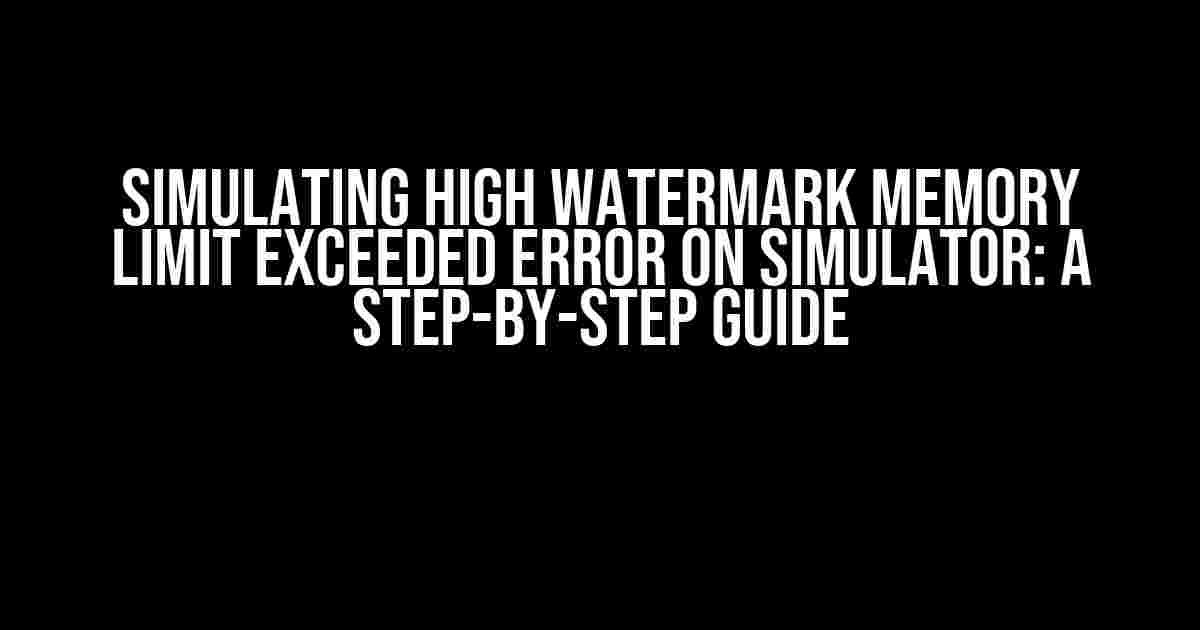Are you tired of encountering the “High Watermark Memory Limit Exceeded” error on your simulator? Do you want to test your application’s memory handling capabilities without waiting for the error to occur naturally? Look no further! In this article, we will show you how to simulate this error on your simulator, ensuring that your app is prepared to handle even the most demanding memory requirements.
Understanding the High Watermark Memory Limit Exceeded Error
Before we dive into the simulation process, it’s essential to understand what the “High Watermark Memory Limit Exceeded” error means. This error occurs when your application exceeds the maximum allowed memory usage on the simulator, causing it to crash or become unstable.
The high watermark refers to the maximum amount of memory your app can use before the system intervenes to prevent memory exhaustion. When your app exceeds this limit, the system will terminate it to prevent crashes and ensure overall system stability.
Why Simulate the High Watermark Memory Limit Exceeded Error?
Simulating the “High Watermark Memory Limit Exceeded” error allows you to:
- Test your app’s memory handling capabilities under extreme conditions.
- Identify and fix memory leaks or inefficient memory usage.
- Optimize your app’s performance by reducing memory consumption.
- Ensure your app can handle sudden spikes in memory usage.
Prerequisites
Before we begin, make sure you have:
- A simulator (e.g., Xcode simulator for iOS or Android Studio emulator for Android).
- Your app’s project open in the simulator.
- A basic understanding of programming concepts (e.g., memory management, CPU usage).
Simulating the High Watermark Memory Limit Exceeded Error
Now, let’s dive into the simulation process. We’ll cover two methods: using Xcode’s built-in tools and creating a custom simulation script.
Method 1: Using Xcode’s Built-in Tools
Xcode provides a built-in feature to simulate memory pressure, which can help you simulate the “High Watermark Memory Limit Exceeded” error.
Follow these steps:
- Open your app’s project in Xcode.
- Navigate to
Xcode Menu > Product > Scheme > Edit Scheme. - In the Scheme editor, select the
Diagnosticstab. - Check the
Simulate Memory Warningcheckbox. - In the
Memory Warning Leveldropdown, selectHigh. - Click
OKto save the changes. - Run your app on the simulator.
- Wait for the memory warning to trigger, which will simulate the “High Watermark Memory Limit Exceeded” error.
Method 2: Creating a Custom Simulation Script
Alternatively, you can create a custom simulation script to simulate the “High Watermark Memory Limit Exceeded” error.
Here’s an example script in Swift:
import Foundation
// Set the memory limit (in MB)
let memoryLimit: Int = 1024
// Allocate a large amount of memory
var memoryConsumption: [Int] = []
for _ in 1...memoryLimit * 1024 * 1024 {
memoryConsumption.append(1)
}
// Print a message to indicate the error
print("High Watermark Memory Limit Exceeded!")
Follow these steps to create and run the script:
- Create a new Swift file in your project (e.g.,
MemorySimulation.swift).) - Copy and paste the script above into the file.
- In the Xcode project navigator, select the simulator target.
- Go to
Xcode Menu > Product > Scheme > Edit Scheme. - In the Scheme editor, select the
Runtab. - In the
Environment Variablessection, add a new variable: - Key:
SIMULATE_MEMORY_PRESSURE - Value:
true - Click
OKto save the changes. - Run your app on the simulator.
- The script will allocate a large amount of memory, simulating the “High Watermark Memory Limit Exceeded” error.
Analyzing and Optimizing Memory Usage
Now that you’ve simulated the “High Watermark Memory Limit Exceeded” error, it’s time to analyze and optimize your app’s memory usage.
Tools for Memory Analysis
Xcode provides several tools to help you analyze memory usage:
| Tool | Description |
|---|---|
| Instruments | A built-in tool for profiling and analyzing app performance, including memory usage. |
| Memory Graph Debugger | A visual tool for identifying memory leaks and optimizing memory usage. |
| Memory Report | A detailed report outlining your app’s memory usage, including allocations and deallocations. |
Optimization Techniques
Here are some optimization techniques to reduce memory usage:
- Use ARC (Automatic Reference Counting) to manage memory automatically.
- Implement efficient data structures and algorithms to reduce memory allocation.
- Use caching and lazy loading to minimize memory usage.
- Optimize image and asset loading to reduce memory consumption.
- Implement memory-efficient data storage solutions (e.g., Core Data).
Conclusion
Simulating the “High Watermark Memory Limit Exceeded” error on your simulator allows you to test your app’s memory handling capabilities and identify areas for optimization. By using Xcode’s built-in tools or creating a custom simulation script, you can ensure your app is prepared to handle even the most demanding memory requirements.
Remember to analyze and optimize your app’s memory usage using Xcode’s tools and implementing efficient memory management techniques. With these strategies, you’ll be well on your way to creating a robust and memory-efficient app that provides a seamless user experience.
Happy coding!
Frequently Asked Question
Get ready to dive into the world of simulator errors and learn how to simulate high watermark memory limit exceeded error on a simulator!
What is a high watermark memory limit exceeded error?
A high watermark memory limit exceeded error occurs when the simulator exceeds the maximum allowed memory allocation, causing the system to crash or become unstable. This error is usually triggered by memory-hungry applications or processes that consume excessive resources.
Why do I need to simulate a high watermark memory limit exceeded error?
Simulating a high watermark memory limit exceeded error allows developers to test and debug their applications under extreme memory conditions, ensuring that their software can handle unexpected memory spikes and crashes. This proactive approach helps identify and fix memory-related issues before they become critical problems in production environments.
How can I simulate a high watermark memory limit exceeded error on a simulator?
To simulate a high watermark memory limit exceeded error, you can use tools like valgrind, AddressSanitizer, or specialized memory profiling software to artificially increase memory allocation and consumption. You can also write custom code to repeatedly allocate and deallocate memory, mimicking the behavior of a memory-hungry application.
What are the benefits of simulating a high watermark memory limit exceeded error?
Simulating a high watermark memory limit exceeded error helps developers identify memory leaks, optimize memory usage, and improve overall system performance. It also enables them to test and refine error-handling mechanisms, ensuring that their applications can recover gracefully from memory-related crashes.
Are there any best practices for simulating a high watermark memory limit exceeded error?
Yes, it’s essential to follow best practices when simulating a high watermark memory limit exceeded error. These include using realistic memory allocation patterns, Gradually increasing memory consumption, and monitoring system performance to avoid unforeseen consequences. It’s also crucial to test and validate simulation results to ensure they accurately reflect real-world scenarios.


